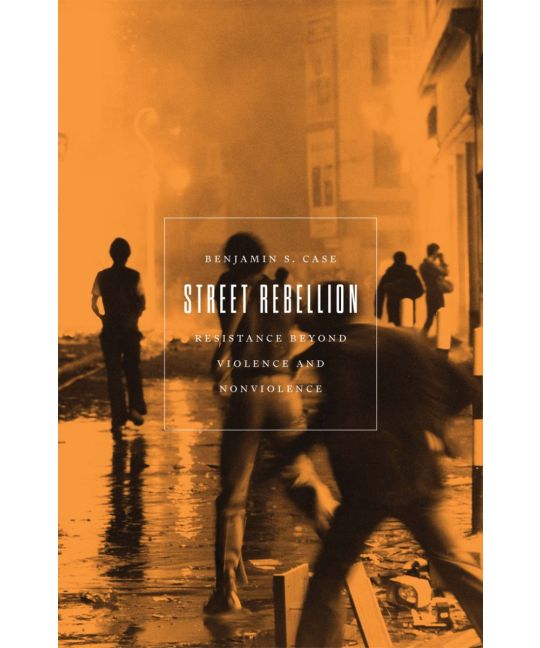ekes reviewed Street Rebellion by Benjamin S. Case
Non-violent action is proven to be the most effective? Right?
5 stars
Movement goals are reached more effectively with strict adherence to non-violent principles, it’s a position that has existed for sometime, but it has taken on a life of its own since XR used it in their seriously fact-light introduction talk. The selective reading of history and creation of data from Chenoweth’s misuse of her own work to create the myth of the 3.5% and all that. Strict enforcement of this rule, rather than strengthening movements, can be divisive and harmful. This is the point where Case, clearly an activist and academic, comes in with this book. Refreshingly for a work coming out of the contentious politics corner it is aimed at activists.
The book has two parts. The first quantitative, the second qualitative, book-ended with clear, but very honest “I say what I’m going to say”, “I say what I said”, introduction and conclusion. The appendix is also important, highlighting all the limitations of the analysis and approaches. It covers so much that most of the criticisms I had while reading the book are covered. All this is completely different to the neatly packaged works which sell the idea that they ‘have done the science and have the solution’.
The violence focused on in the book is the riot. By the end of it I challenge you not to be a bit frustrated by how broad a term that is. The definition that Case uses for the quantitative section is from the Cross-National Time Series Archive (CNTS) “Any violent demonstration or clash of more than 100 citizens involving the use of physical force,” - yes the evident limitations of this archive are discussed. More generally the definition used is the Riot Act’s “a violent disturbance of the peace by a crowd”.
The field of nonviolence studies, Gene Sharp and Erica Chenoweth get the full force of the first part of the book. There has been masses of criticism of the simplistic, sometimes straight incorrect, reading of history, their methodology, the conclusions that follow, and the misapplication of these conclusions. This section covers lots of that ground. While challenging Chenoweth’s Why Civil Resistance Works, Case has what I can only describe as fun combining additional data on riots to the existing list of (Chenoweth defined) successful campaigns. Doing so he is able to suggest, within the limitations of the original, that contrary to the idea these popular uprisings were non-violent, they in fact usually involved a riot. All sorts of effects can be ignored by Chenoweth’s and similar studies, as they claim to focus on quite specific and closely defined movements. Nothing that happens before, after, or around them has validity for the study. Despite this the argument is usually made that there is a demotivating effect of a riot to a movement. The claim is just not backed up by the facts. Case then goes further to outline a different way of analysing the complex dynamics between movements, people, their actions and attempts to repress them.
This leads neatly to looking at those involved. The qualitative section is based on interviews with people involved in ‘riots’, I guess that’s how they might have been reported in the New York Times. The interviewees come from within US Black Blocs and Student Protests in South Africa. These two groups make sense, given the argument being made, they are clearly involved in the protest movements and associated with them. For me, and I suspect for Case too [“there is very little research that investigates interactions between more and less violent forms of unarmed action within movements, and even fewer studies have explored the experiences of rioters themselves”], deeper qualitative research into the even more complex interactions between movements and riots where the participants are less explicitly politically motivated, would be equally, if not more, interesting.
One of the points being made from the interviews is the transformative effect for individuals of being involved in actions that included violence, even the individual did not personally take part in throwing the brick or whatever. This is opposed to being involved in a performative protest march. It is alluded to that physical confrontations could be also performative. The radicalization through transgressions of the rule of law, the taboo or fear of arrest, was clearly something that at least some of XR’s Rising Up formative group had in mind with their non-violent actions designed to encourage arrest. Similar analysis may well find that this was for many people a liberating and positive experience just as in Case’s research of participants in actions that were more physically confrontational. They will probably throw-up negative examples in both too. In the more confrontation examples a concrete difference is the approach to power relations, the former accepts arrest, usually the later literally physically oppose it. As with many texts on the topic the primary reference to underpin this is Frantz Fannon.
There is much more in this book than I’ve covered here. If there can be one thread to conclude it is that collective action does occur. It isn’t something that you can boil down to a set of simplistic repeatable tactics or rules. Here the approaches of contentious politics are better than those of nonviolence studies. It needs more books like these to highlight the complex nature of movements that can, and sometimes do, have power to change society. If it was that easy we’d be in a very different place already.

